Boffis
International Hazard
    
Posts: 1836
Registered: 1-5-2011
Member Is Offline
Mood: No Mood
|
|
Preparation of Sodium Iodate
Preparation of Sodium Iodate from Sodium Chlorate and Iodine
There is an excellent video by Chemplayer on Bitchute (1) on the preparation of potassium iodate from potassium chlorate and iodine. So I decided to
use this as my basic reaction model. But then I spotted in Brauer (p323) (2) under the preparation of sodium periodate a similar preparation, this
time of sodium iodate. Great, I thought, precisely what I wanted.
But when I began to look at the two procedures a major difference became apparent. In Chemplayer’s video they use a molar ratio of iodine to
chlorate of 1.105 while Brauer uses a ratio of 0.671. In other words Brauer uses only half the amount of iodine per mole of chlorate. I couldn't
imagine that sodium or potassium ions change this ratio as they are really only spectator ions.
In my experiment I decided to use an initial ratio of 1. Initially the reaction occurred nicely; exactly as Chemplayer described. When the early
vigorous reaction began to subside I warmed it at 80-90°C for about an hour but some iodine remained and the reaction appeared to have stopped so I
added a bit more sodium chlorate and the remaining iodine largely dissolved but the solution became orange. I presumed this was due to unreacted
iodine in solution as the triiodide ion so I added a pinch more sodium chlorate but this made no difference at all, by this point the iodine to
chlorate ratio had been reduced to 0.838; about halfway between Chemplayer and Brauer.
Interestingly Blanchard (1937) describes the preparation of potassium iodate in an inorganic preparative chemistry books for students and states that
the while the liberated chlorine also oxidizes iodine and then goes on to invite the students to speculate on the nature of these secondary reactions.
Blandchard’s method is for potassium iodate and uses almost the same ratio of iodine to chlorate used by Chemplayer.
I ran two preparations, the first to produce sodium iodate for other experiments and the second, on a smaller scale, to test the effect of using the
ratio of chlorate to iodine used by Chemplayer.
Discussion
Since most descriptions of this preparation state that chlorine is evolved I had originally assumed that the reaction was a simple halogen
displacement:
NaClO3 + I -> NaIO3 + Cl
However, my experience like the observations of Chemplayer is that very little chlorine is evolved and the reaction would therefore appear to be
closer to:
5NaClO3 + 6I + 3H2O -> 5NaCl + 6HIO3
This is somewhat closer to the stoichiometry used by Chemplayer and the amount of alkali used to neutralize the reaction mixture at the end of the
reaction is also in better agreement with this formula. Although the amount of alkali used was slightly less than the ideal which suggests that while
the latter formula is closure to the overall chemistry it is not a precise representation of the reaction which must be more complex.
When a large excess of chlorate is used a complex equilibrium mixture as indicated by the orange or yellow coloured solution reminiscent of the iodine
monochloride present in some iodate titrations at the end point under strongly acid conditions (4). As this mixture is neutralised at the end of the
reaction by the addition of alkali the following equilibrium is disturbed:
5ICl + 3H2O <-> HIO3 + 5HCl + 4I
Driving the reaction to the right and liberating iodine. If the conditions are still sufficiently acid the iodine is rapidly consumed forming iodate.
If the conditions have become alkaline the hypoiodate ions will form transiently then disproportionate into iodate and iodide. This is supported by
the fact that careful acidification of the final filtrate after neutralisation and filtration of the initial product cause the liberation of iodine.
The filtrate was actually acidified until no further iodine was liberated and the iodine filtered off using a fine glass fritted Gooch crucible. After
drying in a desiccator over sulphuric acid 5.20g of iodine were recovered from the crucible and a little more remained in the frit.
Experimental
1) Large scale preparation
79g of sodium chlorate were dissolved in 250ml of warm water and 2ml of concentrated nitric acid added. The solution was heated to about 80°C and
100g of coarsely crystalline iodine added in one go.
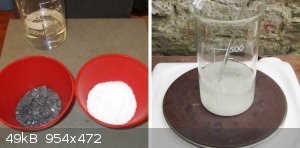
The ingredients iodine and NaClO3 (L) Sodium chlorate dissolving (R)
The reaction was slow to start with but eventually a vigorous reaction set it in and the solution boiled steadily, very little purple iodine vapour
was evident and then only at the beginning, before rapidly ceasing. The smell of chlorine could be detected but the amount released was very small.
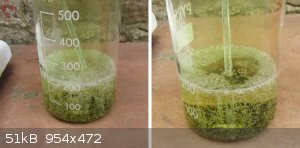
The initial vigorous reaction (L) The reaction subsided- faint yellow vapour (R)
After an hour the vigorous reaction had subsided and heating was required to maintain 80-90°C and some iodine remained so a further 11g of sodium
chlorate were added and heating continued. The volume of solution was topped up from time to time to replace evaporation loses. After another half an
hour a further 10g of sodium chlorate where added as some iodine still remained after a further half an hour (2 hours total reaction time) the iodine
had dissolved but the solution was orange. Believing that this indicated dissolved but unreacted iodine a further 4g of sodium chlorate were added and
the solution heated to 80-90°C for a further half hour but the colour was not affected in the slightest.
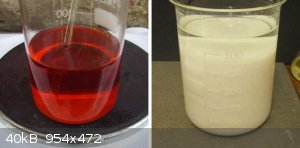
The final orange solution (L) The initial precipitate of NaIO3 on neutralisation (R)
Eventually after about 2.5 hours a white precipitate began to form. Believing this to be a sparingly soluble sodium hydrogen iodate more water was
added to bring the total volume to about 350ml but after reheated to 80°+ the ppt continued to increase in quantity so the solution was neutralised
rapidly with 50% sodium hydroxide solution. 55ml of this solution were measured out and 45ml taken and diluted to 100ml. The, now cloudy, orange
iodate solution was added to the 100ml of alkali with vigorous stirring.
At first a clear solution resulted and then a white precipitate began to form then a transient dark colouration that rapidly disappeared to be
replaced by more white solid. As addition continued the time it took for the dark colour to disappear increased and eventually a grey transient solid
(almost certainly iodine) and purple vapour formed and the time they took to disappear increased. When all of the orange iodate solution had been
added then solution was brown with a mixture of white and dark grey solids in suspension. The rest of the sodium hydroxide was added slowly and
stirred in causing the brown colour to discharge rapidly and the grey solid to disappear more slowly but after about 30 minutes the entire suspension
was pure white.
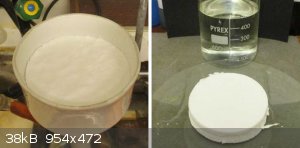
Sodium iodate H2O cake in the filter (L) Filter cake ready to dry and the clear filtrate (R)
When stirring was stopped the solid settled rapidly. The solution was cooled to room temperature (about 15°C) and filtered at the pump in a Buchner
funnel and washed with about 100ml of cold water. The solid cake was sucked as dry as possible and turned out onto a large watch glass to dry. The
dried white finely crystalline powder weighed 152.48g, which if pure sodium iodate monohydrate represents a yield of 89.7%.
The filtrate and washings were preserved. They were carefully neutralised to pH 6.5-7 by the dropwise addition of 80% acetic acid; the solution became
slightly yellow. 10g of strontium chloride hexahydrate dissolved in 20ml of water were then added with vigorous stirring and the cloudy solution
heated almost to boiling and cooled to room temperature and then chilled in the fridge.
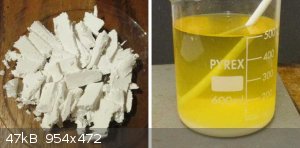
Sodium iodate cake cut up for drying (L) The filtrate after neutralising with acetic acid (R)
The pale straw coloured ppt was filtered off, washed and dried to yield 7.386g of crude strontium iodate monohydrate which represents a further 4.1%
recovery of iodine. It was observed that is the filtrate was acidified with hydrochloric acid iodine was precipitated so the whole of the filtrate was
acidified with 30% hydrochloric acid until no further iodine precipitated. The solution was filtered through a fine glass frit (porosity 4), washed
and dried in a vacuum desiccator. The yield was 5.20g which represents 5.2% of the starting iodine, bringing the total iodine recovered as products to
99% of the starting iodine. The losses were the mechanical loss of iodine in the filter frit and the brown colour of the final filtrate which suggests
the presence of a little iodine, probably as iodine monochloride was still present.
The 152g of crude sodium iodate were recrystallized from 550ml of boiling water. The salt dissolved completely to give a clear solution and so was not
filtered but simply cooled and the chilled overnight in the fridge. The white crystalline product was stirred up to disaggregate the crystals and
filtered. The cake was washed with 100ml of cold water, sucked dry on the filter and then air dried to give 126.22g of pure, white crystalline sodium
iodate.
This represents a recovery of 74.2% of theory based on the original iodine; however, at 4° C the solubility of anhydrous sodium iodate is about 3.3g
per 100ml of water or about 3.6g of monohydrate so in the 550ml of recrystallization filtrate there should be about another 19.7-19.8g of the hydrated
salt still in solution or a further 11.6% of the iodine used. 4.1% of the iodine was recovered as strontium iodate and 5.2% as free iodine so
accounting for >95% of the iodine used.
The filtrate, washings and strontium iodate were preserved for recovery with a later batch.
2) Smaller scale experiment using Chemplayer’s (Blanchard’s) ratio of I2 to chlorate.
15.30g of sodium chlorate were dissolved in 40ml of water in a 250ml conical flask and 0.5ml of conc. Nitric acid added. To this were added 20.0g of
coarsely crystalline iodine that included the 5.2g recovered from the earlier experiment.
The mixture was heated to about 80°C when a vigorous reaction set in and a little purple iodine vapour was evolved. When the reaction subsided the
mixture was heated to a gentle simmer on a hotplate until all of the iodine had dissolved. The final solution was quite clear and colourless; it took
less than an hour to complete.
Once a clear solution was obtained it was carefully neutralised with about 12-13ml of 40% sodium hydroxide solution while still hot. A dense white
precipitate formed immediately and became more crystalline on cooling.
When at room temperature it was chilled in the fridge to about 4°C for several hours and then filtered. The white cake of crude sodium iodate
monohydrate was washed with a little water, drained at the pump and then air dried at 35-40°C overnight. The yield was 31.750g (more than the
theoretical 28.36g!!).
The filtrate and washings were treated with 5.01g of strontium chloride hexahydrate in 25ml of water, heated almost to boiling and cooled. The gritty,
crystalline precipitate of strontium iodate was filtered off, washed and dried to give 1.281g of Sr iodate monohydrate or about 3.6% of the iodine
used.
On acidifying the final filtrate no iodine was liberated but when a few drops of potassium iodide solution were added iodine was liberated. This shows
that no iodide ions were generated during the reaction but that a little iodate persists in the final filtrate.
The crude iodate was recrystallized from the liquor left from recrystallizing the first batch. The original solution was evaporated down to less than
250ml and the 31.75g of crude sodium iodate added. The solution was boiled until the entire solid had dissolved and then slowly cooled to room
temperature. The crystalline solid was filtered off, washed with a little water, drained and then dried on a watch glass at 35°C to give 42.851g of
pure white sodium iodate monohydrate.
Treatment of the filtrate with strontium chloride solution (15g SrCl2.6(H2O)) gave a further 8.066g of white crystalline strontium iodate monohydrate.
3) Recovery of sodium iodate from strontium iodate
8.82g of strontium iodate (about half that recovered) were ground in a small mortar with 30ml of water to a fine milky slurry and a further 20ml of
water used to rinse the mortar into a beaker. 2.2g of anhydrous sodium carbonate were dissolved in the minimum amount of warm water (about 15ml) and
added all at once to the vigorously stirred strontium iodate suspension. The slurry was heated to boil and simmered for 30 minutes, cooled and
filtered. The clear filtrate was evaporated down on a water bath until needle like crystals began to form and then cooled, eventually in the fridge to
4° C. The slurry of crystals was filtered cold and the pure white sodium iodate monohydrate dried at 35-40° C. The yield was 4.56g which represents
a 55% recovery of iodate from the strontium salt. Theoretically the filtrate (about 30ml) should contain about a further 1g of sodium iodate.
It may be possible to retreat the strontium precipitate with dilute acetic acid to remove the strontium carbonate and then treat the iodate residue,
which is much less soluble in dilute acetic acid, with sodium carbonate again but for the small amount of residue I didn’t feel it was worth it in
this case.
Conclusion
It is clear that the ratio of iodine to chlorate used by Chemplayer and also Blanchard gives a cleaner reaction and higher yield of alkali iodate
salt. Using a molar ratio of iodine to chlorate of about 1.1:1 and manipulated with care allows the recovery of alkali iodate of good purity in
>80% yield even after re-crystallisation. With further processing of the filtrate it should be possible to raise this to >95% recovery based on
iodine.
(1) Chemplayer: https://www.bitchute.com/video/W51uN02hxor9/
(2) Brauer; Handbook of Preparative Inorganic Chemistry Vol. I & II. (SM library)
(3) Blanchard; Synthetic inorganic chemistry; 5th ed 1937 (1937)
(4) Vogel; Vogels Textbook of Quantitative Chemical Analysis
|
|
|
S.C. Wack
bibliomaster
    
Posts: 2419
Registered: 7-5-2004
Location: Cornworld, Central USA
Member Is Offline
Mood: Enhanced
|
|
Good to see someone experimenting and reading my scans for a change, but it should be noted that the old directions weren't really followed with such
heating and all; it's not really clear that ratios are the big thing.
Have 2 more...Biltz is very similar to Blanchard, and they're expecting slight losses of iodine and wouldn't want an excess of KClO3 due to similar
solubilities. Inorg Syn (from Hobart Hurd Willard) is the source of Brauer, yet Brauer's sentence "The reaction mixture is then heated, with constant
agitation, to 50-70°C." does not exist in the original, which specifically calls for at least 20% excess NaClO3; which should be easy to separate
from the iodate, although none of these references do.
|
|
|
|